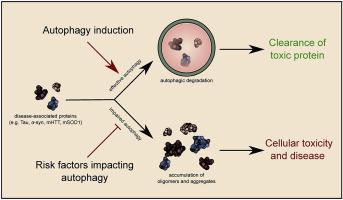当前位置:
X-MOL 学术
›
J. Mol. Biol.
›
论文详情
Our official English website, www.x-mol.net, welcomes your
feedback! (Note: you will need to create a separate account there.)
Autophagy Induction as a Therapeutic Strategy for Neurodegenerative Diseases.
Journal of Molecular Biology ( IF 4.7 ) Pub Date : 2019-12-27 , DOI: 10.1016/j.jmb.2019.12.035 Alvin Djajadikerta 1 , Swati Keshri 1 , Mariana Pavel 2 , Ryan Prestil 1 , Laura Ryan 1 , David C Rubinsztein 1
Journal of Molecular Biology ( IF 4.7 ) Pub Date : 2019-12-27 , DOI: 10.1016/j.jmb.2019.12.035 Alvin Djajadikerta 1 , Swati Keshri 1 , Mariana Pavel 2 , Ryan Prestil 1 , Laura Ryan 1 , David C Rubinsztein 1
Affiliation

|
Autophagy is a major, conserved cellular pathway by which cells deliver cytoplasmic contents to lysosomes for degradation. Genetic studies have revealed extensive links between autophagy and neurodegenerative disease, and disruptions to autophagy may contribute to pathology in some cases. Autophagy degrades many of the toxic, aggregate-prone proteins responsible for such diseases, including mutant huntingtin (mHTT), alpha-synuclein (α-syn), tau, and others, raising the possibility that autophagy upregulation may help to reduce levels of toxic protein species, and thereby alleviate disease. This review examines autophagy induction as a potential therapy in several neurodegenerative diseases-Alzheimer's disease, Parkinson's disease, polyglutamine diseases, and amyotrophic lateral sclerosis (ALS). Evidence in cells and in vivo demonstrates promising results in many disease models, in which autophagy upregulation is able to reduce the levels of toxic proteins, ameliorate signs of disease, and delay disease progression. However, the effective therapeutic use of autophagy induction requires detailed knowledge of how the disease affects the autophagy-lysosome pathway, as activating autophagy when the pathway cannot go to completion (e.g., when lysosomal degradation is impaired) may instead exacerbate disease in some cases. Investigating the interactions between autophagy and disease pathogenesis is thus a critical area for further research.
中文翻译:

自噬诱导作为神经退行性疾病的治疗策略。
自噬是一种主要的保守细胞途径,细胞通过该途径将细胞质内含物传递给溶酶体进行降解。遗传研究表明自噬与神经退行性疾病之间存在广泛的联系,自噬的破坏在某些情况下可能导致病理。自噬可降解导致此类疾病的许多有毒,易聚集的蛋白质,包括突变型亨廷顿蛋白(mHTT),α-突触核蛋白(α-syn),tau等,增加了自噬上调可能有助于降低毒性水平的可能性。蛋白质种类,从而减轻疾病。这项审查审查自噬诱导作为一种潜在的疗法在几种神经退行性疾病-阿尔茨海默氏病,帕金森氏病,聚谷氨酰胺病和肌萎缩性侧索硬化症(ALS)。细胞和体内的证据表明在许多疾病模型中都有希望的结果,其中自噬上调能够降低毒性蛋白的水平,改善疾病征兆并延缓疾病进展。然而,自噬诱导的有效治疗用途需要详细了解疾病如何影响自噬溶酶体途径,因为在某些途径无法完成时(例如,当溶酶体降解受损时)激活自噬可能会加剧疾病。因此,研究自噬与疾病发病机制之间的相互作用是进一步研究的关键领域。自噬诱导的有效治疗用途需要详细了解疾病如何影响自噬溶酶体途径,因为在某些途径无法激活该途径时(例如,当溶酶体降解受损时)激活自噬可能会加剧疾病。因此,研究自噬与疾病发病机制之间的相互作用是进一步研究的关键领域。自噬诱导的有效治疗用途需要详细了解疾病如何影响自噬溶酶体途径,因为在某些途径无法激活该途径时(例如,当溶酶体降解受损时)激活自噬可能会加剧疾病。因此,研究自噬与疾病发病机制之间的相互作用是进一步研究的关键领域。
更新日期:2019-12-27
中文翻译:

自噬诱导作为神经退行性疾病的治疗策略。
自噬是一种主要的保守细胞途径,细胞通过该途径将细胞质内含物传递给溶酶体进行降解。遗传研究表明自噬与神经退行性疾病之间存在广泛的联系,自噬的破坏在某些情况下可能导致病理。自噬可降解导致此类疾病的许多有毒,易聚集的蛋白质,包括突变型亨廷顿蛋白(mHTT),α-突触核蛋白(α-syn),tau等,增加了自噬上调可能有助于降低毒性水平的可能性。蛋白质种类,从而减轻疾病。这项审查审查自噬诱导作为一种潜在的疗法在几种神经退行性疾病-阿尔茨海默氏病,帕金森氏病,聚谷氨酰胺病和肌萎缩性侧索硬化症(ALS)。细胞和体内的证据表明在许多疾病模型中都有希望的结果,其中自噬上调能够降低毒性蛋白的水平,改善疾病征兆并延缓疾病进展。然而,自噬诱导的有效治疗用途需要详细了解疾病如何影响自噬溶酶体途径,因为在某些途径无法完成时(例如,当溶酶体降解受损时)激活自噬可能会加剧疾病。因此,研究自噬与疾病发病机制之间的相互作用是进一步研究的关键领域。自噬诱导的有效治疗用途需要详细了解疾病如何影响自噬溶酶体途径,因为在某些途径无法激活该途径时(例如,当溶酶体降解受损时)激活自噬可能会加剧疾病。因此,研究自噬与疾病发病机制之间的相互作用是进一步研究的关键领域。自噬诱导的有效治疗用途需要详细了解疾病如何影响自噬溶酶体途径,因为在某些途径无法激活该途径时(例如,当溶酶体降解受损时)激活自噬可能会加剧疾病。因此,研究自噬与疾病发病机制之间的相互作用是进一步研究的关键领域。











































 京公网安备 11010802027423号
京公网安备 11010802027423号